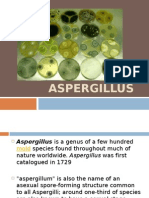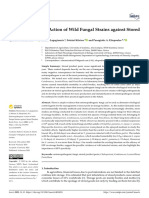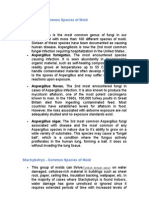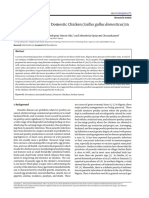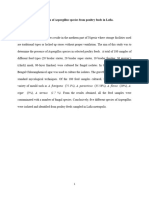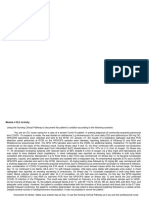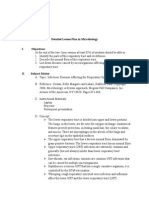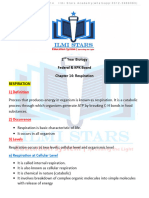A Review On Aspergillosis in Poultry 2157 7579 1000382
A Review On Aspergillosis in Poultry 2157 7579 1000382
Uploaded by
Nofitra Dewi Suparno PCopyright:
Available Formats
A Review On Aspergillosis in Poultry 2157 7579 1000382
A Review On Aspergillosis in Poultry 2157 7579 1000382
Uploaded by
Nofitra Dewi Suparno POriginal Title
Copyright
Available Formats
Share this document
Did you find this document useful?
Is this content inappropriate?
Copyright:
Available Formats
A Review On Aspergillosis in Poultry 2157 7579 1000382
A Review On Aspergillosis in Poultry 2157 7579 1000382
Uploaded by
Nofitra Dewi Suparno PCopyright:
Available Formats
ary Science
Journal of Veterinary
Veterinary Science &
rin
urna of Vete
Girma et al., J Vet Sci Technol 2016, 7:6
&
Tech ology
DOI: 10.4172/2157-7579.1000382
Technology
l
n
Jo
ISSN: 2157-7579
Review Article Open Access
A Review on Aspergillosis in Poultry
Genene Girma1, Mengestie Abebaw1, Mebrie Zemene1*, Yergashewa Mamuye1 and Gashaw Getaneh2
1
Faculty of Veterinary Medicine, Department of Veterinary Pharmacy, University of Gondar, Gondar, Ethiopia
2
Faculty of Veterinary Medicine, Department of Biomedical Science, University of Gondar, Gondar, Ethiopia
Abstract
Aspergillosis is a respiratory disease of chicken, turkey, humans and other mammals and less frequently ducks,
pigeon, geese and other wild and domestic birds. It is cuased by a fungal species under the genus Aspergillus. In
chickens and turkey, the disease may be endemic on some farm. In wild birds, it appears too sporadic, frequently
affecting only an individual bird. It is usually seen in birds of 7-40 days old. Aspergillus spp are ubiquitous and the
disease is found where ever environmental condition is favorable for growth. Aspergillus fumigatus is frequently
isolated in affected bird. Infection occurs by inhalation of spores. The disease has two forms, acute and chronic form.
The acute form occurs when large amount of spores are ingested by the bird, where as, the chronic form affects birds
under immune suppression. The clinical signs are non-specific and a variety of diagnostic procedures are required
for the diagnosis of aspergillosis in poultry, of which culturing is very important. Treatment of aspergillosis is not
effective and prevention is the best way of controlling the disease. Good managemental practices such as sanitation,
avoiding wet litter or soil and moldy or dusty feeds, provididing adequate ventilation, and disinfecting feed and water
lines should be implemented to prevent and control the disease.
Keywords: Aspergillosis; Aspergillus fumigatus; Pevenetion found in Aspergillus nidulans that can be reproduced by ascospores.
When grow start hyphae, together forming mycelia. Vegetative mycelia
Introduction consists of superficial hyphae and hyphae on the surface are aerial
Aspergillosis is non-contagious disease of avian. It is cuased mycelia. This structure produce conidiophore, these are formed in foot
by a fungal species under the genus Aspergillus. The disease occurs cells and end in a vesicle, in this stricter grow one line of phyalides
under immune compromised situations of the host or when the bird or one line of mutulae and over this stricter one line of phyalides
is exposed to an overwhelming number of spores. Stress is the main that produce a chain of conidia or spores. Conidia are uni or multi
predisposing factor for the development of the disease [1]. It is a nucleated but always single celled [6].
common mismanagement problem in commercial and back yard
poultry. The disease primarily affects lower respiratory system [2]. The function of the conidia is dissemination of the fungus.
Aspergillus is useable as a food in many different substances because of
Aspergillus spp can penetrate egg shell and infect the embryo. the number of enzyme that it can produce. The two main requirement
The infected embryo may die or hatch with well developed lesion. If
of substance for fungal growth are organic matter and moisture, if both
infected eggs are broken, large numbers of spores are released, which
contaminate the hatchery equipment [3]. Aspergillosis can be acute or factors are present the fungus can grow in almost any substance. The
chronic form. Acute aspergillosis generally occurs in young birds and shape can be globose, elliptical or oval, and the surface can be smooth or
resulting in high morbidity and mortality. The chronic form is sporadic finely rough. The color of conidia determines the color of the conidial
and it causes lesser mortality and generally affects older birds, especially head which also determine the color of the colony [7].
a compromised immune system due to poor husbandry condition [2].
Kingdom Fungi
Poor sanitation in the house as well as food contamination promotes
Division Ascomycota
fungal growth. Poor ventilation in conjunction with these factor increase
Class Eurotiomycetes
the possibility of invassion and infection of birds’ respiratory system by air
Order Eurotiales
borne spore [2]. Mycotoxins are toxic secondary metabolites produced by
Family Trichocomaceae
organisms of the fungus. Aflatoxin is a type of mycotoxins produced by
Genus Aspergillus
Aspergillus flavus and Aspergillus parasiticus and ochratoxin is produced by
Aspergillus ochraecus that affect poultry when they consume contaminated Source: [5]
food [4-6]. Therefore, the objectives of this paper are to highlight about Table 1: Taxonomy of Aspergillus.
poultry Aspergillosis (Table 1).
Etiology *Corresponding author: Mebrie Zemene, Lecturer, Faculty of Veterinary Medicine,
Department of Veterinary Pharmacy, University of Gondar, Gondar, Ethiopia, Tel:
Aspergillosis in poultry is cuased by a fungal species under 251918518866; E-mail: zemenemebrie@gmail.com
the genus Aspergillus. Organisms cultured from affected organ in Received July 12, 2016; Accepted August 31, 2016; Published September 05,
decreasing frequency are: Aspergillus fumigates, A. flavus, A. niger, A. 2016
glaucus and A. terreus. From these spp, A. fumigatus is a common cause Citation: Girma G, Abebaw M, Zemene M, Mamuye Y, Getaneh G (2016) A
of the disease. These organisms are common soil saprophytes which Review on Aspergillosis in Poultry. J Vet Sci Technol 7: 382. doi: 10.4172/2157-
grow on organic matter in warm (>25°C) and also humid environment, 7579.1000382
and damaged egg in hatchery [7,8]. Copyright: © 2016 Girma G, et al. This is an open-access article distributed under
the terms of the Creative Commons Attribution License, which permits unrestricted
Most of the species under the genus Aspergillus are classified as use, distribution, and reproduction in any medium, provided the original author and
fungi imperfect (asexual reproduction) but the perfect state has been source are credited.
J Vet Sci Technol, an open access journal
ISSN: 2157-7579 Volume 7 • Issue 6 • 1000382
Citation: Girma G, Abebaw M, Zemene M, Mamuye Y, Getaneh G (2016) A Review on Aspergillosis in Poultry. J Vet Sci Technol 7: 382. doi:
10.4172/2157-7579.1000382
Page 2 of 5
Epidemiology Clinical sign
Aspergillus spp are ubiquitous and the disease has a worldwide Aspergillosis may involve many body systems; fungal spores most
distribution and may be found whereever environmental condition commonly invade trachea, air sacs and lung. Signs depend on the
is favorable for fungal growth. These organisms are common soil number of spore that enter the body and organ system affected but can
saprophytes and grow on organic matter in warm (>25°C) humid be generally reflected as disease of respiratory tract, occasionally the
environments including damaged egg in hatcheries and poor ventilation CNS [7]. There are three common presentation of the disease; diffuse
system. The disease more frequently occurs in tropical countries like lower respiratory tract diseases, syringeal graunloma and focal CNS
Ethiopia. Sever outbreak associated with hatchery contamination may graunuloma particularly in the brain [13].
result in up to 15% chicken mortality during the first two weeks and Within the first 3-5 days newly hatched chicken infected in the
decrease growth rate on affected survivors [2]. hatchery show a very rapid and difficult breathing and start breathing
Concerning the distribution of Aspergillosis among different with an open mouth (gaspers) due to the gradual obstruction of the air
seasons, [8] reported that the disease is prevailing throughout passage [14]. Survivor may become dull and stunted, show sleepiness,
the year but in hot and humid weather condition, the percentage lack of appetite, emaciation, increased thirst, develop eye swelling or
of positive isolates in both lung and environmental samples was blindness and show torticolis (twisting of the neck to one side). Other
higher in summer (50% and 41.2%) respectively, followed by winter birds may remain subclinically affected for some times but later slowly
season which was (29.2% and 29.4%) respectively as compared with develop breathing problems. This is because increasing body weight
other seasons of the year. These are because of the warm, humid put demands on the reduced functional capacity of the lung [15].
environment and the disease in winter season is common when Infected poultry usually show mortality in two phases: Acute
indoor gas levels tend to be highest. respiratory disease may cause 5-50% mortality in the first 1-3 weeks
of age. Those which survive usually develop chronic disease with up
Transmision and predisposing factors to 5% mortality due to pulmonary insufficiency, ascitis, blindness
Aspergillosis affects avian spp, other animals and humans. All or neurological fungal metastasis. A common feature of dyspnea
birds are susceptible to aspergillosis. It is reported in domestic birds associated with aspergillosis is the lack of respiratory noise [15] (Figure 1).
like poultry, duck, and quails as well as in wild bird [2]. Inhalation Necropsy finding
of conidia or spores from contaminated feed, fecal material, soil and
contamination of egg in ovo, infect the developing embryo. Higher The primary location of lesions is the lungs and air sacs although
susceptibility of birds to aspergillosis may be attributed to anatomic other organs may be involved. Extensive involvement of the respiratory
and physiologic characteristics of the avian respiratory system. The tract can occur before development of clinical signs. Lesions vary in
small non-expanding lungs and nine air sacs constitute a primary size from pinhead or miller seed (milliary <1 mm in diameter) white
nidus for infection because the air (or conidia) reaches the caudal to yellowish granulomas up to the size of a pea. Roughly spherical
air sacs before it pass through those part of the lungs in which the granulomatous nodules (>2 cm) may also be observed in serosa and
gas exchange takes place [9]. Higher body temperature also allows parenchyma of the other organs involved [16].
quick fungal growth. Other factors include chronic stress, unsanitary Pulmonary lesions are characterized by multiple hard creams
conditions, overcrowding, malnutrition, vitamin deficiencies especially to yellow colored, circumscribe plaques a few mm to several cm in
vitamin A and overuse of certain medications (corticosteroids) as well diameter seen throughout the lungs surface, inside the lungs, scattered
as respiratory irritants (disinfectant fumes and aerosol sprays). Birds in ventral surface of sternum and air passages on gross examination
that are otherwise ill or are very young or old are also susceptible (Figures 2a and 2b). The plaques also found in the syrinx, air sacs,
to aspergillosis [10]. The incidence of aspergillosis increased when
chicken reared on saw dust than rice husk as litter and incidence was
67.74% and 32.26% respectively might be due to high moisture content
of saw dust allowing more fungal growth than rice husk [11].
Pathogenesis
Aspergillosis is caused by inhalation of overwhelming numbers
of small, hydrophobic fungal spores (conidia) into the respiratory
tract. After infective spores invade tracheal, nasal, bronchial and air
sac epithelium, they penetrate the respiratory tissue and reproduce
by single division of tubular hyphae to form mycelia and they initiate
granulomas at this site. Then they are disseminated hematogeneously
to the other tissue like brain, pericardium, bone marrow, kidney and
other soft tissue. Tissue invasion creates an inflammatory condition
and inflammatory response with hetrophils, lymphocytes, monocytes
and some giant cells infiltrating the lesion and produce lesion [12].
Chronic disease especially in turkey often terminate in impendence
of pulmonary blood flow caused by enlarging pulmonary granulomas
and this cause right ventricular dilatation and ascitis. Another
mortality cause for aspergillosis included exudates to become lodged
in the trachea or syrinx producing acute respiratory embarrassment in
Figure 1: Structure of Aspergillus [5].
chronically infected individuals [13].
J Vet Sci Technol, an open access journal
ISSN: 2157-7579 Volume 7 • Issue 6 • 1000382
Citation: Girma G, Abebaw M, Zemene M, Mamuye Y, Getaneh G (2016) A Review on Aspergillosis in Poultry. J Vet Sci Technol 7: 382. doi:
10.4172/2157-7579.1000382
Page 3 of 5
debilitating, voice change or exercise intolerance [24]. Granulomatous
nodules and /or cheesy plaques on the serosa and parenchyma of
respiratory tracts as well as other organs are observed. But, definitive
diagnosis is based on the isolation of Aspergillus species by culture or
by the detection of the organism during histological examination [25].
Identification can also be made by preparing a wet smear. For this, a
nodule can be dissected out and crushed on a slide beneath a cover slip
in a drop of 20% potassium hydroxide and lactophenol cotton blue.
The lactophenol cotton blue stains the fungal hyphae. Wet mounts can
also be prepared from sputum or nasal swabs in either 10% KOH and
Calcofluor or Parker inkand/or Gram stain [26].
The tissue samples (lungs, trachea, pharynx and thoracic air sacs
as well as other organs) fixed in 10% neutral buffered formalin are
Figure 2: a. Lung shows the presence of cream color nodules in plural surface,
air sacs (arrow). b. Creamy to yellow color nodules shows throughout the lung processed and embedded in paraffin blocks and stain with haematoxylin
(arrow) [11]. and eosin (HE) method. Aspergillus hyphae stained poorly in H and
E stained sections. Differential stains such as Periodic acid-Schiff
liver and intestines. Lung parenchyma wasconsolidated and single or (PAS), Bauer’s and Gridley’s stains differentiate and easily identify the
multiple necrotic areas are visible on cut surfaces of lungs [11]. hyphae and mycelia. Special stains for fungus Grocott’s and Gomori
Methanamine Silver stain should be employed to detect the presence of
Mycotic pododermatitis along with pulmonary aspergillosis was
reported in turkeys. In footpads, keratinized epidermal disruption, fungal hyphae. For proper identification of the species, the pathogenic
encrustations and acute inflammation were noted [17]. Epidermal organism must be isolated by culturing it on differential media. Small
cysts associated with A. fumigatus have been described in the comb pieces of lesions aseptically removed are placed onto plates or slants
of a silky bantam chicken [18]. It leads to periorbital swelling, swollen containing malt agar, Sabouraud’s glucose agar or antibiotics and
and adhered eyelids with turbid discharge, cloudy cornea and cheesy incubated at 37°C for 24 hours. Species of Aspergillus can be identified
yellow exudates within the conjunctival sac [19]. Osteo-arthritis and by observing the characteristic conidial head and colony [16].
granulomatous osteoarthritis of the hip joints with necrosis of the
femur head was observed in turkey [20]. Differential Diagnosis
Visceral organs were involved in aspergillosis with formation of The differential diagnosis includes infectious bronchitis
nodular granulomatous lesions. Right ventricular dilatation or cor (dyspnea), newcastle disease (watery greenish diarrhea), infectious
pulmonale due to pulmonary hypertension may occur with or without larngeo tracheaties (gasping, cough and extension of the neck during
ascites in poultry [21]. Abscesses in the cerebellum and cerebrum were inspiration), dactylaria infection (nervous sign) and nutritional
reported. It may occur with or without pulmonary and other lesions. encephalomalacia [27].
In the cerebellum of broiler breeders and turkeys, circumscribed white
to greyish areas were observed. Granuloma formation was also seen in
the brain and lungs of layer chicken [22].
Histopathology
The microscopical examination showed congestion of pulmonary
and perialveolar blood vessel and perivascular edema (Figure 3).
The normal architecture of the lung and air sacs were replaced by
disseminated granulomatous foci. The center of the granulomatous
foci contained caseous necrosis and necrotic cellular debris surrounded
by rims of heterophils, lymphocytes, macrophages and multinucleated Figure 3: a. Showing congestion of pulmonary, perialveolar blood vessel
giant cells was seen (Figure 3). The nodules consisted of coagulative and diffuse edema of pulmonary tissues (arrow) in Lung. b. Areas of caseous
necrotic center (Figure 4). A few, more severe, densification and necrosis (black arrow) and cellular debris (red arrow) in lung [11].
inflammatory lesions were focally present on the pleura and the
underlying pulmonary lobules (Figure 4) [11].
Diagnosis
Signs of aspergillosis are non-specific and making diagnosis
is difficult. Moreover, no single test provides certainty. Diagnosis
usually relay upon an accumulation of evidence from history, clinical
presentation, postmortem findings, hematology, biochemistry,
serology, radiographic changes, endoscopy, and culture of the fungus.
Cases of aspergillosis in birds are often diagnosed based on postmortem
findings of white caseous nodules in the lungs or air sacs of affected
birds since clinical diagnosis is difficult [23]. The history of the bird can Figure 4: Aspergillosis showing granuloma formation with caseated center
(arrow) in lung. b. Diffuse densification of the pleural parenchyma by congestion
reveal a stressful event and some under lining environmental factors and and an inflammatory cellular infiltration (arrows) in lung [11].
immune suppressive condition or treatment. It may also reveal chronic
J Vet Sci Technol, an open access journal
ISSN: 2157-7579 Volume 7 • Issue 6 • 1000382
Citation: Girma G, Abebaw M, Zemene M, Mamuye Y, Getaneh G (2016) A Review on Aspergillosis in Poultry. J Vet Sci Technol 7: 382. doi:
10.4172/2157-7579.1000382
Page 4 of 5
Treatment with pre-existing asthma who present eosinophlia and intermittent
bronchial obstruction [31-34].
Treatment for Aspergillosis is not effective because the drug used
does not reach the fungus that is walled off by the bird’s inflammatory Conclusion and Recommendations
response and therefore, isolated from the blood stream. This disease
has a poor prognosis when the infection in the tissue is extensive Aspergillosis is a disease of respiratory system of chicken, humans,
and only systemic drugs are used. The best treatment results if the mammals and wild birds and caused by genus Aspergillus, which
granulomatuos lesion is dried and topical treatment in conjunction is distributed worldwide and it is soil saprophyte. It is a common
with systematic therapy is given. Treatment of aspergillosis involves mismanagement problem and causes a high mortality in chicken.
the use of one or more systemic antifungal agent. Drugs which are Environmental factors play an important role in the development of
commonly used include itraconazole, ketoconazole, clotrimazole, the disease include the number of spores to which the bird exposed,
miconazole, fluconazole and Amphotercin B. From these drugs, poor sanitation in the house as well as food contaminated with faces
itraconazole is a choice of treatment of the disease [11]. promote for fungal growth. Poor ventilation in conjunction with other
factor increases the possibility of occurrence of the infection. There is
Prevention and control no effective treatment for the disease.
Aspergillosis has no effective treatment and prevention by Based on the above conclusion, the following recommendations
vaccination is not commercially practicable. Therefore, control are forwarded:
depends on reducing exposure to the fungus and associated risk factors.
• Cleaning and disinfection of feed and water utensils
Aspergillus fumigatus in young chicken has been somewhat controlled
by hatchery sanitation. Moldy litter or feed should be avoided to prevent • Poultry house must be well ventilated.
outbreak of aspergillosis. It is advisable to treat poultry house and litter
with antifungal compounds [28]. Any moldy feed should be removed, • Avoid overcrowding in poultry house.
bulk feed container should be cleaned, old litter should be removed • Avoid moldy or dusty feed.
from house and replaced with new. Hatching equipment and air ducts
should be cleaned, disinfected and well monitored. Contaminated • Proper Sanitation of hatching equipment.
hatchery should be fumigated with formaldehyde or thiabendazole • Treat poultry house and disinfect the litter with antifungal
120-360 g/m3 [13]. compound.
Public Health Significance of Aspergillosis • Cull infected birds to prevent further contamination.
Aspergillosis has a zoonotic importance and recent outbreak of Use mold inhibitor in the feed for suspected outbreak.
aspergillosis in chicken have left the chicken consuming population References
shocked and frightened. Aspergillosis is transmitted to man by
handling infected birds and animals, inhalation of spores from infected 1. Saif YM, Fadly AM, Glisson JR, McDougald LR, Nolan LK, et al. (1999) Disease
of poultry. 12th edn. Iowa State University Press, Ames, London, pp: 542-550.
feed and litter, poor sanitation and poor hygienic condition and by
eating under cooked contaminated poultry [29]. Most mycotoxins 2. Jordan F, Pattisson M, Alexander D, Faragher T (2002) Poultry Disease. 5th
edn. Elsevier Limited, Saunders, UK, pp: 387-390.
produced by aspergillus are not broken down by cooking temperature
and there is no safe way to salvage grain or food that has been molded. 3. Bauk L (1994) Mycosis. In: Avian medicine principle and application. Ritchie
It is transmitted via inhalation or ingestion [2]. BW, Harrison GJ, Harrison LR (eds). Wingers Publishing Inc., Lake Worth,
USA, pp: 174-180.
Three disease states are observed in man and these are: first;
4. Richard JL, Calnk BW (1997) Aspergillosis and disease of poultry. 10th edn.
Infection that can arise from weakening effect of aspergillosis, for Iowa State University Press, Ames, London, pp: 125-130.
example colonization of the lung cavities due to tuberculosis, neoplasm
5. Kearns KS, Loudis B (2003) Recent advances in avian infectious agent.
or new growth in the lung or kidney almost in organ system in human
body may be involved. Onychomycosis, sinusitis, cerebral aspergillosis, 6. Shane SM (2005) Handbook on Poultry Diseases. 2nd edn. American Soybean
pulmonary aspergillosis, cutaneous aspergillosis, hepatic aspergillosis as Association, USA.
well as disseminated aspergillosis may develop. Nosocomial occurrence 7. Atlaman RB (1997) Avian Medicine and Surgery. Saunders, Philadelphia, USA,
of aspergillosis due to catheters and other devices is also likely to occur pp: 89-92.
in hospital environment and is a major risk for the development of 8. Lobna MA, Salem AAF (2014) Epidemiological study of Aspergillosis in chickens
Aspergillosis particularly neuropenic patients. Second; Allergic and human contacts in chicken farms at Kalyoubia Governorate. IOSR Journal
reaction to Aspergillus spp, for example allergic bronchopulmonary of Agriculture and Veterinary Science (IOSR-JAVS) 7: 20-24.
aspergillosis (ABPA). Third; toxic reactions occur as result of toxin 9. Nardoni S, Ceccherelli R, Rossi G, Mancianti F (2006) Aspergillosis in Larus
produced by Aspergillus spp. Aflatoxins which are carcinogenic, induce cachinnans micaellis: survey of eight cases. Mycopathologia 161: 317-321.
hepatocellular carcinoma or liver cancer [10]. 10. Coles BY (1997) Avian Medicine and Surgery. 2nd edn. Blackwell Science,
London, pp: 333-340.
Aspergillosis establishes itself in patients debilitating by chronic
disease such as diabetes, cancer, tuberculosis and disease of immune 11. Sultana S, Rashid SMH, Islam MN, Ali MH, Islam MM, et al. (2015) Pathological
system, as well as in person treated with antibiotics, anti metabolites, Investigation of Avian Aspergillosis in Commercial Broiler Chicken at Chittagong
District. International Journal of Innovation and Applied Studies 10: 366-376.
and corticosteroids for prolonged period [30]. Persons occupationally
exposed for long periods to materials contaminated by fungus spores 12. Kunkle RA, Rimiler RB (1996) Pathology of Acute Aspergillosis in Turkeys.
(grain, hay, cotton, wool and other) run a greater risk. Normal children Avian Dis 40: 875-886.
who inhale large number of conidia may develop fever and dyspnea. 13. Pattisson M, McMullin P, Bradbury J, Alexander D, Jordan F (2008) Poultry
Allergic bronchopulmonary aspergillosis (ABPA) occurs in patients disease. 6th edn. Elsevier Limited, Saunders, UK, pp: 428-431.
J Vet Sci Technol, an open access journal
ISSN: 2157-7579 Volume 7 • Issue 6 • 1000382
Citation: Girma G, Abebaw M, Zemene M, Mamuye Y, Getaneh G (2016) A Review on Aspergillosis in Poultry. J Vet Sci Technol 7: 382. doi:
10.4172/2157-7579.1000382
Page 5 of 5
14. Aguilar RF, Redig PT (1995) Diagnosis and treatment of avian aspergillosis. 25. Kim JY, Kim JM, Mo IP (2011) Multisystemic Aspergillosis with Granulomas in
Current Veterinary Therapy XII. Philadelphia, PA: WB Saunders, pp: 1294-1299. Layer Chickens. Korean J Poult Sci 38: 45-50.
15. Vegad JL (2008) Poultry diseases: a guide for farmers and poultry professionals. 26. Charlton BR, Chin RP, Barnes HJ (2008) Fungal infections. In: Diseases of
2nd edn. International Book Distributing Co., India, pp: 179-181.
Poultry. Saif YM, Fadly AM, Glisson JR, McDougald LR, Nolan LK, et al. (eds.).
16. Fowler ME (1993) Zoo & Wild Animal Medicine Current Therapy. Volume 3. WB Iowa State University Press, Ames, Iowa, USA, Chapter 9, pp: 989-998.
Saunders & Co., Philadelphia: USA, pp: 178-181.
27. Olgebsee BL, Altaman RB, Clubb SL (1997) Avian medicine and surgery.
17. Cannon M (1999) Aspergillosis in poultry. J Med Surg Aquat Birds 327: 527-568. Philadelphia Saunders, USA, pp: 564-570.
18. Curities P (1990) A hand book of poultry and game birds. 4th edn. Blackwell 28. Kunkle RA (2003) Aspergillosis. In: Diseases of Poultry. Saif YM, Fadly AM,
Publishing, London, pp: 123-130.
Glisson JR, McDougald LR, Nolan LK, et al. (eds.). Iowa State University
19. Leishangthem GD, Singh ND, Brar RS, Banga HS (2015) Aspergillosis in Avian Press, Ames, Iowa, USA, pp: 883-895.
Species: A Review. J Poult Sci 3: 01-14.
29. Horrer FJ, Clank BW (1997) Poisons and toxins. Disease of poultry. 10th edn.
20. Stoute ST, Bickford AA, Walker RL, Charlton BR (2009) Mycotic pododermatitis
and mycotic pneumonia in commercial turkey poults in northern California. J 30. Kahn CM (2010) The Merk Veterinary Manual. 9th edn. Merck and Co., Inc.,
Vet Diagn Invest 21: 554-557. White House Station, NJ, USA, pp: 654-660.
21. Suedmeyer WK, Bermudez AJ, Fales WH (2002) Treatment of epidermal cysts 31. Jones MP, Orosz SE, Cox SK, Fraizier DL (2000) Pharmacokinetic Disposition
associated with Aspergillus fumigatus and Alternaria species in a silky bantam of Itraconazole in Red-Tailed Hawks (Buteo jamaicensis). Avian Med Surg 14:
chicken. J Avian Med Surg 16: 133-137.
15-22.
22. Hoppes S, Gurfield N, Flammer K, Colitz C, Fisher P (2000) Mycotic keratitis in a
blue-fronted Amazon parrot (Amazona aestiva). J Avian Med Surg 14: 185-189. 32. Abrams GA, Paul-Murphy J, Ramer JC, Murphy CJ (2001) Aspergillus
blepharitis and dermatitis in a peregrine falcon-gyrfalcon hybrid (Falco
23. Olias P, Hauck R, Windhaus H, van der Grinten E, Gruber AD, et al. (2010) peregrinus × Falco rusticolus). J Avian Med Surg 15: 114-120.
Articular aspergillosis of hip joints in turkeys. Avian Dis 54: 1098-1101.
33. Ivey ES (2000) Serologic and Plasma Protein Electrophoretic Findings in 7
24. Höfle U, Blanco JM, Rodriguez A, Vicente A (2001) Atypic aspergillosis* a new threat
to the Iberian imperial eagle (Aquila adalberti). In: Korbel R (ed.), Proceedings of Psittacine Birds with Aspergillosis. J Avian Med Surg 14: 103-106.
the German Veterinary Medical Society, 6th European AAV-DVG Conference of the 34. Pedon N, Boris SF (2003) Zoonosis and communicable disease common to
Association of Avian Veterinarians, 4th Scientific ECAMS Meeting of the European
man and animals. 3rd edn. Washington, DC, PAHO. pp: 305-310.
College of Avian Medicine and Surgery, p: 288.
J Vet Sci Technol, an open access journal
ISSN: 2157-7579 Volume 7 • Issue 6 • 1000382
You might also like
- Nelson Textbook of Pediatrics, 22nd Edition 2024 Volume OneDocument2,230 pagesNelson Textbook of Pediatrics, 22nd Edition 2024 Volume Onebostonhopskin396% (24)
- Final Oral Revalida Internal Medicine Compilation 1Document45 pagesFinal Oral Revalida Internal Medicine Compilation 1Joel SaluNo ratings yet
- Allergy To Fungi in Veterinary MedicineDocument13 pagesAllergy To Fungi in Veterinary Medicineconsejocomunallasoledad2022No ratings yet
- Laprak Infectious CoryzaDocument10 pagesLaprak Infectious CoryzaSekar BiruNo ratings yet
- Flystrike Among Domestic Animals: An OverviewDocument3 pagesFlystrike Among Domestic Animals: An OverviewInternational Journal of Innovative Science and Research TechnologyNo ratings yet
- TLE 8 Q3W8 Animal ProdDocument8 pagesTLE 8 Q3W8 Animal Prodplaq0% (1)
- Parasite Infections in Poultry Environments (Case Report On Gallus Domesticus Endoparasite)Document41 pagesParasite Infections in Poultry Environments (Case Report On Gallus Domesticus Endoparasite)Dembi TulsaNo ratings yet
- ANS 304 Poultry Production 2Document10 pagesANS 304 Poultry Production 2Yin KuzNo ratings yet
- AspergillusDocument53 pagesAspergillusማላያላም ማላያላም100% (1)
- Some Common Health Problems of PoultryDocument4 pagesSome Common Health Problems of PoultryTakougalamoNo ratings yet
- Health ManagementDocument24 pagesHealth Managementronalit malintadNo ratings yet
- Ijarbs10 PDFDocument12 pagesIjarbs10 PDFRafika GuciNo ratings yet
- Clinafarm Brochure JanDocument8 pagesClinafarm Brochure JanDrivailaNo ratings yet
- ch28Document63 pagesch28Renata CezarNo ratings yet
- Intro To EntoDocument41 pagesIntro To EntoRowie WanawanNo ratings yet
- Grain Molds andDocument21 pagesGrain Molds andkarki Keadr DrNo ratings yet
- Ijarbs 10Document14 pagesIjarbs 10amanmalako50No ratings yet
- Ajls 20210903 11Document3 pagesAjls 20210903 11Garuma NemeraNo ratings yet
- Swine Erysipelas Its Epidemiology Diagnosis Treatment Control Preventive Measures and Comprehensive ReviewDocument8 pagesSwine Erysipelas Its Epidemiology Diagnosis Treatment Control Preventive Measures and Comprehensive ReviewKeto PrehranaNo ratings yet
- Virulence of Four Beauveria Bassiana (Balsamo) (Asc., Hypocreales) Isolates On Rose Saw Y, Arge Rosae Under Laboratory ConditionDocument5 pagesVirulence of Four Beauveria Bassiana (Balsamo) (Asc., Hypocreales) Isolates On Rose Saw Y, Arge Rosae Under Laboratory ConditionShellGarciaNo ratings yet
- Health ManagementDocument29 pagesHealth Managementronalit malintadNo ratings yet
- Insects 14 00091Document11 pagesInsects 14 00091Rahul JaganNo ratings yet
- Microscopic Exam of FungiDocument13 pagesMicroscopic Exam of FungijadeyjadeNo ratings yet
- About The Diseases: AnthraxDocument2 pagesAbout The Diseases: Anthraxsasmita100% (1)
- Common Spesies of MoldDocument4 pagesCommon Spesies of Moldn4zer100% (2)
- Infectious DiseasesDocument6 pagesInfectious Diseasesdahiphale1No ratings yet
- Inflammatory ResponseDocument6 pagesInflammatory Responsestephen mwangiNo ratings yet
- Internal Parasite Control in Cattle: James E. Strickland Extension Veterinary ScienceDocument8 pagesInternal Parasite Control in Cattle: James E. Strickland Extension Veterinary ScienceAbdulmalik FeroozNo ratings yet
- Insect and Fungal Attack On SeedsDocument12 pagesInsect and Fungal Attack On Seedsmomina tayyabNo ratings yet
- Markes Disease by DR AbdelazizDocument8 pagesMarkes Disease by DR Abdelazizابراهيم القويعىNo ratings yet
- LP6 Mycology 2021Document14 pagesLP6 Mycology 2021JOHNERROL CARCELLARNo ratings yet
- IntroductionDocument91 pagesIntroductionJayson BasiagNo ratings yet
- Aspergillosis by Gaurav KambojDocument4 pagesAspergillosis by Gaurav KambojmehakNo ratings yet
- NewcastleDocument8 pagesNewcastledawitworku143No ratings yet
- Detection of Fungi Infecting Maize Zea Mays L Seeds in Different Storages Around Jimma Southwestern Ethiopia 2157 7471 1000338 PDFDocument6 pagesDetection of Fungi Infecting Maize Zea Mays L Seeds in Different Storages Around Jimma Southwestern Ethiopia 2157 7471 1000338 PDFDjibode EstherNo ratings yet
- Intestinal Parasites of Domestic ChickenDocument4 pagesIntestinal Parasites of Domestic Chickenfood heheNo ratings yet
- Common Diseases of Commercial Broiler PoultryDocument21 pagesCommon Diseases of Commercial Broiler Poultrykarki Keadr Dr85% (13)
- MicroparaDocument5 pagesMicroparaNathaniel BudayNo ratings yet
- Chlamydiosis, Psittacosis, OrnithosisDocument13 pagesChlamydiosis, Psittacosis, OrnithosisSatria 'arceus' DewantaraNo ratings yet
- Butcher Et Al 1999 Reviewed 2015 Common Poultry Diseases Univ. Florida Extension Doc PS04400Document15 pagesButcher Et Al 1999 Reviewed 2015 Common Poultry Diseases Univ. Florida Extension Doc PS04400Don KirkwoodNo ratings yet
- presterl2018Document5 pagespresterl2018lakshman kumarNo ratings yet
- AspergillusDocument15 pagesAspergillusAbdullateef AbdulmusawwirNo ratings yet
- ASPERGILLUSDocument27 pagesASPERGILLUSAbdullateef AbdulmusawwirNo ratings yet
- Tinjauan Tentang Aspergillus SP.: KingdomDocument3 pagesTinjauan Tentang Aspergillus SP.: KingdomRuth Michelia SavitriNo ratings yet
- Staab 2009Document23 pagesStaab 2009Break The RulesNo ratings yet
- Report About Fowlpox and Avian Encephalomyetis -1Document6 pagesReport About Fowlpox and Avian Encephalomyetis -1Archy FranciscoNo ratings yet
- Aspergillus Niger ThesisDocument6 pagesAspergillus Niger Thesissarahgordonanchorage100% (2)
- Mycotoxogenic MoldsDocument40 pagesMycotoxogenic MoldsAimen fatimaNo ratings yet
- Past and Future Vaccination Against EimeriaDocument13 pagesPast and Future Vaccination Against EimeriaAndres ForeroNo ratings yet
- Tu Ic HlnaDocument3 pagesTu Ic HlnaTaye DemissieNo ratings yet
- Introduction To Medical Mycology: by Prof Ashraf MOGAHEDDocument61 pagesIntroduction To Medical Mycology: by Prof Ashraf MOGAHEDlianazulak100% (2)
- FixedDocument16 pagesFixedAdri versouisseNo ratings yet
- Remvt14 053 060Document9 pagesRemvt14 053 060ANGEL ALEXIS LEON BENITEZNo ratings yet
- Fungal MicrobiologyDocument10 pagesFungal MicrobiologyGrace joy DoocNo ratings yet
- Fungal Pathogenesis Lecture NotesDocument4 pagesFungal Pathogenesis Lecture NotesElla BoyceNo ratings yet
- Diagnostic Medical Microbiology: Pseudomonas AeruginosaDocument7 pagesDiagnostic Medical Microbiology: Pseudomonas AeruginosaIM CTNo ratings yet
- Giardia: PROTOZOA Is A Group of Phyla That Comprises The Single-Celled Microscopic Animals, WhichDocument5 pagesGiardia: PROTOZOA Is A Group of Phyla That Comprises The Single-Celled Microscopic Animals, WhichAilah OtaganNo ratings yet
- Diagnostic Medical Microbiology: Pseudomonas AeruginosaDocument7 pagesDiagnostic Medical Microbiology: Pseudomonas AeruginosaDjdjjd SiisusNo ratings yet
- The Occurrence of Aspergillus Fumigatus in Respiratory InfectionsDocument2 pagesThe Occurrence of Aspergillus Fumigatus in Respiratory InfectionsAyman KamalNo ratings yet
- Atlasof Fungal SporesDocument4 pagesAtlasof Fungal SporesAmeer IsmailNo ratings yet
- 911 Pigeon Disease & Treatment Protocols!From Everand911 Pigeon Disease & Treatment Protocols!Rating: 4 out of 5 stars4/5 (1)
- Medical Application Form - June 30 2022Document4 pagesMedical Application Form - June 30 2022Ankita NiravNo ratings yet
- Stridor or WheezeDocument29 pagesStridor or Wheezekrishna mandalNo ratings yet
- PccnexamhandbookDocument26 pagesPccnexamhandbookstilnocs22No ratings yet
- Pneumothorax and AsthmaDocument8 pagesPneumothorax and AsthmaKyle FernandezNo ratings yet
- AtelectasisDocument3 pagesAtelectasisabdo mo . M7.No ratings yet
- Pneumothorax: Risk Factors For A PneumothoraxDocument12 pagesPneumothorax: Risk Factors For A Pneumothoraxyangi dokaNo ratings yet
- MLA Content Map PDF 85707770Document39 pagesMLA Content Map PDF 85707770Ahsan KhanNo ratings yet
- Family Practice Guidelines, Fourth Edition (Book + Free App) - 4th Edition. ISBN 0826153410, 978-0826153418Document23 pagesFamily Practice Guidelines, Fourth Edition (Book + Free App) - 4th Edition. ISBN 0826153410, 978-0826153418catherintenchfq504100% (9)
- Geria IntroDocument15 pagesGeria IntrojsNo ratings yet
- Nejme 2305752Document2 pagesNejme 23057525fqkqkcdhtNo ratings yet
- Community Care PlanDocument6 pagesCommunity Care PlanKristian Dave DivaNo ratings yet
- Study Island1Document17 pagesStudy Island1Farah FarahNo ratings yet
- DMAS Low Acuity Non Emergent ER Diagnosis Code ListDocument17 pagesDMAS Low Acuity Non Emergent ER Diagnosis Code ListLia TabackmanNo ratings yet
- ADRIANO BONDOC ORSOLINO VIADOR - Docx 1Document10 pagesADRIANO BONDOC ORSOLINO VIADOR - Docx 1Luis LazaroNo ratings yet
- Lesson PlanBioDocument15 pagesLesson PlanBiobelNo ratings yet
- Metafile 962Document53 pagesMetafile 962wullurparkja3No ratings yet
- Syllab BSC RTDocument24 pagesSyllab BSC RTKiruba HaranNo ratings yet
- Cardiopulmonary Symptoms: Chapter OutlineDocument24 pagesCardiopulmonary Symptoms: Chapter OutlinedinakarcNo ratings yet
- Brett Williams, Linda Ross - Paramedic Principles and Practice - A Clinical Reasoning Approach-Elsevier (2020) 2Document2,810 pagesBrett Williams, Linda Ross - Paramedic Principles and Practice - A Clinical Reasoning Approach-Elsevier (2020) 2Melvin RuizNo ratings yet
- Ventilatory Management of Severe Bronchopulmonary Dysplasia - A Very Short ReviewDocument32 pagesVentilatory Management of Severe Bronchopulmonary Dysplasia - A Very Short Reviewnoeldtan.neoNo ratings yet
- Maharashtra University of Health Science, Nashik: Physiotherapy Syllabus III - B.P.THDocument28 pagesMaharashtra University of Health Science, Nashik: Physiotherapy Syllabus III - B.P.THDevasyaNo ratings yet
- Class 12 Biology Chapter 14 NotesDocument23 pagesClass 12 Biology Chapter 14 NotesSyed Atta Ur RahmanNo ratings yet
- Myths in Infection ControlDocument30 pagesMyths in Infection ControlDukeNo ratings yet
- Case Summary of Patient With Chronic Obstructive PulmonaryDocument27 pagesCase Summary of Patient With Chronic Obstructive PulmonaryUzair Muhd0% (1)
- 302 RUA - Interview WorksheetDocument4 pages302 RUA - Interview WorksheetChristy RobinettNo ratings yet
- Sci9 Q1 Mod2 Effects of Lifestyle On The Respiratory and Circulatory Systems Version3 Edited3Document23 pagesSci9 Q1 Mod2 Effects of Lifestyle On The Respiratory and Circulatory Systems Version3 Edited3NOVA LESLIE AGAPAYNo ratings yet
- ACOSDocument14 pagesACOSDejan ŽujovićNo ratings yet
- Heal Briefing Air Serbia EngDocument4 pagesHeal Briefing Air Serbia EngSladjana TeslićNo ratings yet








